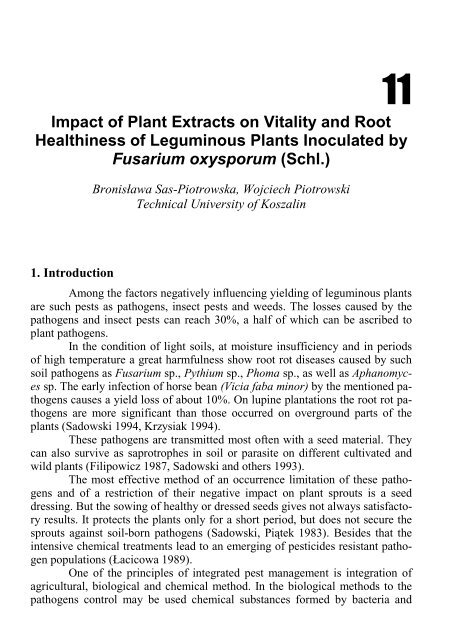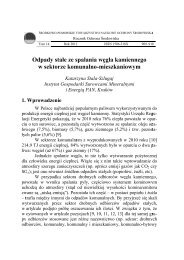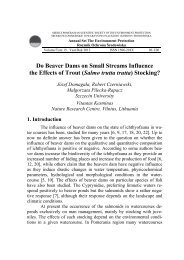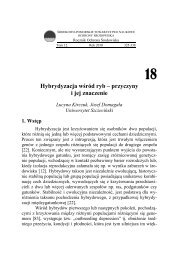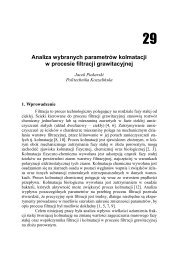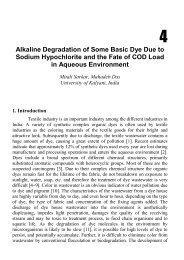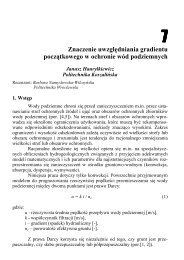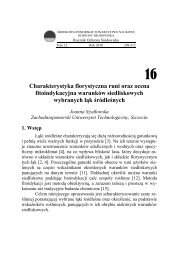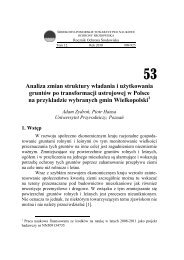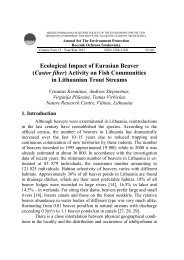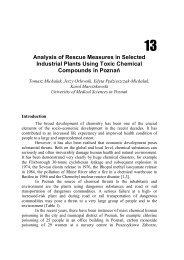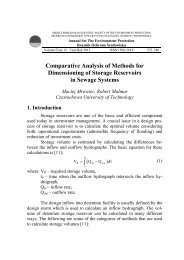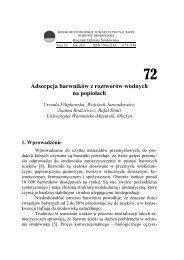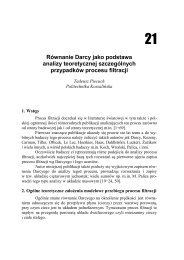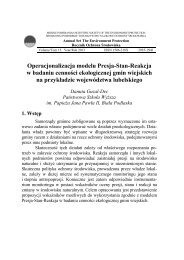Bronisława Sas-Piotrowska, Wojciech Piotrowski
Bronisława Sas-Piotrowska, Wojciech Piotrowski
Bronisława Sas-Piotrowska, Wojciech Piotrowski
You also want an ePaper? Increase the reach of your titles
YUMPU automatically turns print PDFs into web optimized ePapers that Google loves.
11<br />
Impact of Plant Extracts on Vitality and Root<br />
Healthiness of Leguminous Plants Inoculated by<br />
Fusarium oxysporum (Schl.)<br />
1. Introduction<br />
<strong>Bronisława</strong> <strong>Sas</strong>-<strong>Piotrowska</strong>, <strong>Wojciech</strong> <strong>Piotrowski</strong><br />
Technical University of Koszalin<br />
Among the factors negatively influencing yielding of leguminous plants<br />
are such pests as pathogens, insect pests and weeds. The losses caused by the<br />
pathogens and insect pests can reach 30%, a half of which can be ascribed to<br />
plant pathogens.<br />
In the condition of light soils, at moisture insufficiency and in periods<br />
of high temperature a great harmfulness show root rot diseases caused by such<br />
soil pathogens as Fusarium sp., Pythium sp., Phoma sp., as well as Aphanomyces<br />
sp. The early infection of horse bean (Vicia faba minor) by the mentioned pathogens<br />
causes a yield loss of about 10%. On lupine plantations the root rot pathogens<br />
are more significant than those occurred on overground parts of the<br />
plants (Sadowski 1994, Krzysiak 1994).<br />
These pathogens are transmitted most often with a seed material. They<br />
can also survive as saprotrophes in soil or parasite on different cultivated and<br />
wild plants (Filipowicz 1987, Sadowski and others 1993).<br />
The most effective method of an occurrence limitation of these pathogens<br />
and of a restriction of their negative impact on plant sprouts is a seed<br />
dressing. But the sowing of healthy or dressed seeds gives not always satisfactory<br />
results. It protects the plants only for a short period, but does not secure the<br />
sprouts against soil-born pathogens (Sadowski, Piątek 1983). Besides that the<br />
intensive chemical treatments lead to an emerging of pesticides resistant pathogen<br />
populations (Łacicowa 1989).<br />
One of the principles of integrated pest management is integration of<br />
agricultural, biological and chemical method. In the biological methods to the<br />
pathogens control may be used chemical substances formed by bacteria and
<strong>Bronisława</strong> <strong>Sas</strong>-<strong>Piotrowska</strong>, <strong>Wojciech</strong> <strong>Piotrowski</strong><br />
fungi, and as well as by plants. It is known that most of plants produces compounds<br />
with allelochemical, biocidial and biostatical effect (Achremowicz, CieŜ<br />
1992). The biological activity of plant extracts depends however on several factors,<br />
and first of all on content of specific chemical compounds and on their<br />
ability to diffuse. Besides that some those compounds may stimulate a pathogen<br />
development and increase a degree of contamination and the others can act as<br />
inhibition factors (<strong>Sas</strong>-<strong>Piotrowska</strong> and others 1995b, 1996). The impact on protected<br />
plants is also of importance.<br />
The aim of the investigations carried out was a laboratory evaluation of<br />
a fungicidal activity of extracts from polygonaceous plants against Fusarium<br />
oxysporum, root rot agents on Papilionaceae plants.<br />
2. Material and methods<br />
The material used in investigations was as follows :<br />
Polygonaceous plants (Polygonaceae) from which the extracts were prepared,<br />
and namely Polygonum bistorta L., P. hydropiper L., P. convolvulus L., P.<br />
persicaria L., P. aviculare L and P. sachalinense Schmidt. The investigated<br />
in vivo plant extracts were prepared in a form of water extracts (maceration<br />
and infusion) as well as alcohol and acetone solutions. The way of their preparation<br />
was given in earlier studies (<strong>Sas</strong>-<strong>Piotrowska</strong>, <strong>Piotrowski</strong> 1997).<br />
Seeds of following leguminous plants: horse bean (Vicia faba L. ssp. minor),<br />
white lupine (Lupinus albus L.), yellow lupine (Lupinus luteus L.)<br />
Fungus Fusarium oxysporum (Schl.) causing the root rot diseases of leguminous<br />
plants. Its culture was carried out on Petri dishes with a PDA nutrient<br />
medium. From one week old cultures of F. oxysporum overgrowed<br />
with mycelium, agar discs with a diameter of 5 mm were cut and served as<br />
an infection material.<br />
The experimental method was as follows: disinfected and rinsed in a<br />
sterile distilled water seeds were dressed in rotary seed dresser with one of the<br />
mentioned extracts (7 minutes), and then the seeds were left for 20 hours. The<br />
next day the seeds were put in suitably prepared glass tubes, the overgrowed<br />
with fungus mycelium agar discs were put on and all was plugged with a cotton<br />
wool. After 2 weeks of incubation in conditions of natural lighting and ambient<br />
temperature the healthiness and vitality evaluation were made:<br />
as a criterion of healthiness a degree of root infection was taken, and a 9 -<br />
grade scale were applied, where 1 o - lack of infection symptoms , 9 o - dark<br />
browned and dead roots. The analysis of variance was carried out on the according<br />
to Townsend-Heuberger formula transformed values;<br />
as a criterion of vitality a root length in cm and their mass in g were taken.<br />
192<br />
Middle Pomeranian Scientific Society of the Environment Protection
Impact of plant extracts on vitality and root healthiness of leguminous plants ...<br />
The experiment was conducted in two periods and 4 replications for<br />
each of investigated factors performing altogether 14400 evaluations for each<br />
criterion. The research results were assessed using a single analysis of variance<br />
and a linear correlation.<br />
3. Research results<br />
The extracts made from the polygonaceous plants (regardless of the<br />
preparation way), as well as the extracts made according to other procedures<br />
(regardless of their origin) significantly differentiated the root infection of Vicia<br />
faba minor, L. albus, L. luteus by F. oxysporum (Fig. 1) and the vitality of these<br />
plants (Fig. 2 and 3).<br />
20<br />
10<br />
0<br />
-10<br />
-20<br />
-30<br />
-40<br />
40<br />
30<br />
20<br />
10<br />
0<br />
-10<br />
-20<br />
-30<br />
-40<br />
-50<br />
-60<br />
Fig.1A; LSD = 6,64**<br />
V,f.minor L.albus L.luteus<br />
P.bistorta P.hydropiper P.convolvulus P.persicaria P.aviculare<br />
Fig.1B; LSD = 6,07**<br />
V.f.minor L.albus L.luteus<br />
Macerate<br />
Middle Pomeranian Scientific Society of the Environment Protection 193<br />
Brew<br />
Alcohol<br />
Acetone<br />
Fig. 1. The root infection by F. oxysporum depending on origin (A) and preparation<br />
way (B) of an extract (deviation from control, %)<br />
Rys. 1. PoraŜenie korzeni przez F.oxysporum w zaleŜności od pochodzenia (A) i sposobu<br />
(B) przygotowania wyciągu (odchylenie od kontroli, %)
<strong>Bronisława</strong> <strong>Sas</strong>-<strong>Piotrowska</strong>, <strong>Wojciech</strong> <strong>Piotrowski</strong><br />
The infection of L. albus roots by F. oxysporum was limited by the extracts<br />
made from all investigated Polygonaceous plants, and particularly from P.<br />
persicaria and P. bistorta (Fig. 1a). Similar effects were observed in relation to<br />
the way of their preparation (Fig. 1b). The most strong action was showed by<br />
the water extracts (maceration and infusion). The infection of V.f. minor and L.<br />
luteus roots was limited however by the extracts from P. bistorta, P. aviculare<br />
and P. sachalinense, and especially by maceration and alcohol extracts from<br />
Polygonaceous plants.<br />
The performed statistical analysis proved furthermore a significant interaction<br />
between these factors (extract origin x preparation way)as well as between<br />
these ones and investigated leguminous plant species. They differed<br />
among themselves with response changeability in relation to the used extracts. It<br />
was the highest for L. albus (V = 44,0%), and the lowest for L. luteus<br />
(V = 15,5%). Furthermore, the impact of the extracts on the healthiness on plant<br />
species was sometimes different. A significant impact conformity was stated in<br />
comparison of the extracts on healthiness of V.f.minor and L. luteus (r= 0,452*).<br />
In remaining cases a tendency to a negative correlation appeared. It found an<br />
reflection in final results showed in tables 1, 2 and 3. It results from there that:<br />
infection of V.f. minor by F. oxysporum was limited most strongly by macerated<br />
extracts from P. bistorta and P. aviculare and by alcohol extract from<br />
P. aviculare;<br />
in case of L. albus there were infusions from P. persicaria and P. hydropiper<br />
as well as acetone extract from P. convolvulus;<br />
in case of L. luteus there were alcohol extracts from P. sachalinense and P.<br />
aviculare and macerated extract from P. sachalinense.<br />
In addition to root healthiness of leguminous plants those parameters as<br />
a root and shoot length and mass were measured. These parameters were considered<br />
as an information regarding a possible phytotoxic or stimulating action on<br />
plant vitality of compounds contained in the extracts.<br />
It was found, that in most cases, the diminished infection by F. oxysporum<br />
was accompanied by an increasing of plant vitality. This correlation was however<br />
proved only for V.f.minor by the impact of the extracts on root infection and their<br />
interaction on sprouts length (r=-0,610**) and on roots length (r=-0,733**). When<br />
the roots healthiness of V.f.minor with a green mass and roots mass, as well as roots<br />
healthiness of L. albus with a mass and length of green parts were compared a tendency<br />
for a reverse phenomenon was observed - the more the extracts from polygonaceous<br />
plants limited the root infection by F. oxysporum the stronger was also the<br />
decreasing of plant vitality.<br />
The results collected on diagrams 2a and 2b show that L. albus responded<br />
with a clear decrease of length and mass of green parts on extracts<br />
194<br />
Middle Pomeranian Scientific Society of the Environment Protection
Impact of plant extracts on vitality and root healthiness of leguminous plants ...<br />
made from P. bistorta and P.hydropiper. The sprout length was alsow reduced<br />
by extracts from P. aviculare and its mass by extracts from P. persicaria. The<br />
impact of the extracts on these features was significantly correlated<br />
(r= 0,905**) by L. albus, what however was not observed in a case of V.f.minor.<br />
The sprout length of this plant was limited solely by the extracts from P. persicaria.<br />
The extracts from P. bistorta have also reduced the sprouts length and<br />
their mass by L. luteus (r = 0,537**). In remaining cases a stimulating action of<br />
the extract on sprouts length and mass was observed.<br />
30<br />
20<br />
10<br />
0<br />
-10<br />
-20<br />
50<br />
40<br />
30<br />
20<br />
10<br />
0<br />
-10<br />
-20<br />
-30<br />
sprout length<br />
V.f.minor<br />
sprout mass sprout length<br />
L.albus<br />
Fig.2A;<br />
LSD sprout length = 8,90**<br />
LSD sprout mass = 6,26**<br />
sprout mass sprout length<br />
L.luteus<br />
sprout mass<br />
P.bistorta P.hydropiper P.convolvulus P.persicaria P.aviculare<br />
root length<br />
V.f.minor<br />
root mass root length<br />
L.albus<br />
Fig.2B;<br />
LSD root length = 7,92**<br />
LSD root mass = 5,83**<br />
root mass root length<br />
L.luteus<br />
root mass<br />
P.bistorta P.hydropiper P.convolvulus P.persicaria P.aviculare<br />
Fig. 2 (A, B). The vitality of leguminous plants depending on an extract origin (deviation<br />
from control, %)<br />
Rys. 2 (A, B). śywotność roślin strączkowych w zaleŜności od pochodzenia wyciągu<br />
(odchylenie od kontroli, %)<br />
The action of investigated extracts on green parts (length and mass of<br />
the sprouts) and on root system (length and mass of roots) was in a range of L.<br />
albus and L. luteus significantly positively correlated. The values of the correlation<br />
coefficients oscillated by L. albus from r = 0,560** to r = 0,905**, and by<br />
Middle Pomeranian Scientific Society of the Environment Protection 195
<strong>Bronisława</strong> <strong>Sas</strong>-<strong>Piotrowska</strong>, <strong>Wojciech</strong> <strong>Piotrowski</strong><br />
L. luteus from r = 0,502* to 0,618**. In a case of V.f.minor these relationships<br />
were proved solely for sprouts and roots length (r = 0,726**) and for sprouts<br />
and roots mass (r = 0,912**).<br />
A significant conformity was stated also for the response of a root system<br />
of V.f.minor (r = 0,407*), L. albus (r = 0,709**) and L. luteus (r = 0,502*),<br />
which was measured by its length and mass. However L. luteus has responded<br />
on substances contained in most extracts from polygonaceaus plants with a clear<br />
decrease of roots mass, by a simultaneous increase of their length (Fig.2a and<br />
2b). A slight reducing of a development of a root system of L albus was caused<br />
by the extract from P. hydropiper. An increasing of a length and mass of V.f.<br />
minor roots was stimulated by all extracts from those polygonaceous plants investigated.<br />
80<br />
60<br />
40<br />
20<br />
0<br />
-20<br />
-40<br />
-60<br />
80<br />
60<br />
40<br />
20<br />
0<br />
-20<br />
-40<br />
-60<br />
-80<br />
196<br />
sprout length<br />
V,f.minor<br />
Fig.3A;<br />
LSD sprout length = 8,13**<br />
LSD sprout mass = 5,78**<br />
sprout mass sprout length<br />
L.albus<br />
sprout mass sprout length<br />
L.luteus<br />
Fig.3B;<br />
LSD root length = 7,24**<br />
LSD root mass = 5,31**<br />
sprout mass<br />
root length root mass root length root mass root length root mass<br />
V,f.minor L.albus L.luteus<br />
Macerate<br />
Brew<br />
Alcohol<br />
Acetone<br />
Macerate<br />
Brew<br />
Alcohol<br />
Acetone<br />
Fig. 3 (A i B). The vitality of leguminous plants depending on a preparation way of an<br />
extract (deviation from control, %)<br />
Rys. 3 (A i B). śywotność roślin strączkowych w zaleŜności od sposobu przygotowania<br />
wyciągu (odchylenie od kontroli, %)<br />
Middle Pomeranian Scientific Society of the Environment Protection
Impact of plant extracts on vitality and root healthiness of leguminous plants ...<br />
A significant influence on plant vitality exerted also the way of extracts<br />
preparing (Fig. 3a and 3b). The development of underground and aboveground<br />
parts of V.f.minor was reduced by acetone extracts, and of L. albus – by alcohol<br />
extracts. In a case of L. luteus a negative impact on root mass exerted maceration<br />
and infusion extracts, which however caused the increase of their length.<br />
Furthermore a significant interaction was found between an extract origin<br />
and a way of its preparation as well as between these factors and investigated<br />
leguminous plant species. They differed between themselves with a reaction<br />
variability on used extracts. The variability coefficients (V%) oscillated by<br />
V. faba minor from 21,02 (root length) to 38,16 (sprout length), by L. albus<br />
from 10,21 (root mass) to 14,56 (sprout length), by L. luteur from 17,35 (sprout<br />
length) to 58,84 (root mass).<br />
An extract influence on a vitality of investigated leguminous plant species,<br />
which was evaluated with different criteria was not significantly correlated.<br />
It indicates that a direction and intensity of V.f.minor, L. albus and L. luteus reaction<br />
on used plant extracts for seed dressing were different (Tables 1,2,3).<br />
Table 1. The healthiness and vitality of Vicia faba ssp. minor depending on an extract<br />
(deviation from control, %)<br />
Tabela 1. Zdrowotność i Ŝywotność Vicia faba ssp. minor w zaleŜności od wyciągu<br />
(odchylenie od kontroli, %)<br />
Mean Range Inhibition<br />
ROOT INFECTION<br />
Stimulation<br />
P.bistorta; macerate (-38,0) P.convolvulus; acetone (44,9)<br />
3,8 -38,0÷44,9 P.aviculare; macerate (-37,1) P.aviculare; brew (42,6)<br />
P.aviculare; alcohol (-28,1)<br />
ROOT LENGTH<br />
P.hydropiper, brew (36,9)<br />
P.bistorta; acetone (-40,1) P.aviculare; macerate (67,1)<br />
11,1 -40,1÷67,1 P.convolvulus; acetone (-20,9) P.bistorta; macerate (47,4)<br />
P.persicaria; alcohol (-20,5)<br />
ROOT MASS<br />
P.sachalinense; acetone (42,5)<br />
P.bistorta; acetone (-53,0) P.bistorta; brew (97,6)<br />
13,9 -53,0÷97,6 P.convolvulus; acetone (-51,0) P.persicaria; brew (91,9)<br />
P.aviculare; acetone (-26,6)<br />
SPROUT LENGTH<br />
P.convolvulus; brew (83,2)<br />
P.convolvulus; acetone (-70,6) P.convolvulus; macerate (78,4)<br />
7,1 -70,6÷78,4 P.hydropiper, acetone (-46,9) P.aviculare; macerate (75,0)<br />
P.bistorta, acetone (-43,4)<br />
SPROUT MASS<br />
P.bistorta; macerate (73,6)<br />
P.convolvulus; acetone (-43,6) P.convolvulus; brew (86,3)<br />
20,9 -43,6÷86,3 P.persicaria; acetone (-15,8) P.bistorta; brew (83,9)<br />
P.aviculare; acetone (-15,4) P.hydropiper: brew (71,4)<br />
Middle Pomeranian Scientific Society of the Environment Protection 197
198<br />
<strong>Bronisława</strong> <strong>Sas</strong>-<strong>Piotrowska</strong>, <strong>Wojciech</strong> <strong>Piotrowski</strong><br />
Table 2. The healthiness and vitality of Lupinus albus depending on an extract (deviation<br />
from control, %)<br />
Tabela 2. Zdrowotność i Ŝywotność Lupinus albus w zaleŜności od wyciągu (odchylenie<br />
od kontroli, %)<br />
Mean Range Inhibirion<br />
ROOT INFECTION<br />
Stimulation<br />
P.persicaria; brew (-68,7) P.sachalinense; acetone (74,9)<br />
-19,7 -68,7÷74,9 P.hydropiper; brew(-57,6) P.aviculare; acetone (40,1)<br />
P.convolvulus; acetone (-57,4)<br />
ROOT LENGTH<br />
P.hydropiper; alcohol (-23,2)<br />
P.hydropiper; alcohol (-30,8) P.aviculare; acetone (38,1)<br />
3,8 -30,8÷38,1 P.persicaria; alcohol (-7,7) P.convolvulus; macerate (21,1)<br />
P.aviculare; macerate (-5,3)<br />
ROOT MASS<br />
P.bistorta; macerate (17,7)<br />
P.hydropiper; alcohol (-17,3) P.aviculare; acetone (29,3)<br />
5,3 -17,3÷29,3 P.bistorta; acetone (-12,0) P.persicaria; brew (18,0)<br />
P.hydropiper; acetone (-6,0)<br />
SPROUT LENGTH<br />
P.hydropiper; brew (18,0)<br />
P.bistorta; alcohol (-36,0) P.aviculare; acetone (30,8)<br />
0,6 -36,0÷30,8 P.hydropiper; alcohol (-29,9) P.bistorta; macerate (16,0)<br />
P.bistorta; acetone (-20,4)<br />
SPROUT MASS<br />
P.convolvulus; alcohol (13,3)<br />
P.bistorta; alcohol (-38,7) P.aviculare; acetone (21,3)<br />
-3,1 -38,7÷21,3 P.bistorta; acetone (-25,9) P.bistorta; macerate (10,6)<br />
P.bistorta; brew (-17,0) P.convolvulus; alcohol (7,3)<br />
Middle Pomeranian Scientific Society of the Environment Protection
Impact of plant extracts on vitality and root healthiness of leguminous plants ...<br />
Table 3. The healthiness and vitality of Lupinus luteus depending on an extract (deviation<br />
from control, %)<br />
Tabela 3. Zdrowotność i Ŝywotność Lupinus luteus w zaleŜności od wyciągu (odchylenie<br />
od kontroli, %)<br />
Mean Range Inhibition<br />
ROOT INFECTION<br />
Stimulation<br />
P.sachalinense; alcohol (-27,6) P.hydropiper; acetone (23,0)<br />
-2,7 -27,6÷23,0 P.aviculare; alcohol (-21,8) P.persicaria; brew (22,6)<br />
P.sachalinense; macerate (-20,1)<br />
ROOT LENGTH<br />
P.persicaria; acetone (20,6)<br />
P.persicaria; brew (-42,7) P.persicaria; alcohol (102,2)<br />
21,4 -42,7÷102,2 P.bistorta; acetone (-18,9) P.hydropiper; brew (72,0)<br />
P.persicaria; brew (-18,2)<br />
ROOT MASS<br />
P.sachalinense; alcohol (66,7)<br />
P.persicaria; brew (-73,9) P.persicaria; alcohol (119,6)<br />
-9,1 -73,9÷119,6 P.sachalinense; brew (-62,2) P.sachalinense; alcohol (90,0)<br />
P.bistorta; brew (-58,7)<br />
SPROUT LENGTH<br />
P.convolvulus; alcohol (80,4)<br />
P.persicaria; brew (-29,0) P.aviculare; acetone (48,9)<br />
11,6 -29,0÷48,9 P.aviculare; macerate (-9,1) P.aviculare; alcohol (43,4)<br />
P.bistorta; acetone (-8,2)<br />
SPROUT MASS<br />
P.sachalinense; alcohol (42,3)<br />
P.bistorta; alcohol (-16,9) P.sachalinense; alcohol (106,8)<br />
8,6 -16,9÷106,8 P.persicaria; brew (-9,9) P.persicaria; alcohol (91,2)<br />
P.aviculare; macerate (-9,9) P.hydropiper; brew (24,9)<br />
4. Discussion<br />
The occurrence in a soil of pathogenic factors with differeniated susceptibility<br />
towards fungicides causes that the chemical control of pathogenic fungi<br />
causing root rot is not easy (Jańczak 1992). For seed dressing there are used besides<br />
of fungicides also antibiotic substances, and lately a fungicidial compounds<br />
produced by plant are searched (<strong>Piotrowski</strong>, <strong>Sas</strong>-<strong>Piotrowska</strong> 1995).<br />
With these compounds contained in plant tissue there is connected their resistency<br />
against pathogens and pests (Trzebiński 1970). These compounds are<br />
known under the name of antibiotics or phytoncides.<br />
Receiving of new plant varieties with high yielding possibilities and<br />
good economic properties is negatively connected with a content of these compounds.<br />
Decreasing of phenoles in maize was strongly correlated with intensity<br />
of attack by Ostrinia nubilalis (Dąbrowski 1988).<br />
In investigations of <strong>Piotrowski</strong> and others (1995) it was proved that<br />
among 100 tested maceration extracts only some of these have hampered ger-<br />
Middle Pomeranian Scientific Society of the Environment Protection 199
<strong>Bronisława</strong> <strong>Sas</strong>-<strong>Piotrowska</strong>, <strong>Wojciech</strong> <strong>Piotrowski</strong><br />
mination of spores and caused deformation of hyphae. It was first of all a maceration<br />
extract made from P. bistorta, which hampered germination of Ascochyta<br />
fabae, Botrytis fabae, Fusarium culmorum and Alternaria alternata. In other<br />
papers (<strong>Sas</strong>-<strong>Piotrowska</strong>, <strong>Piotrowski</strong> 1995a, b) where an impact of extracts from<br />
polygonaceous plants on pathogenes causing spot diseases by V.f.minor was<br />
analyzed, a high activity have shown also alcohol and acetone extracts from P.<br />
bistorta. In present investigations it was found however, that a maceration extract<br />
from P. bistorta is active also in relation to F. oxysporum. An application<br />
of this extract for seed dressing have reduced an infection of V.f.minor by this<br />
pathogene.<br />
A favorable action of an extract from P. bistorta on plant healthiness<br />
depends on ist chemical composition, and particularly the content of almost<br />
25% of vegetable tannines, as well as gallic and ellagic acids (OŜarowski 1980).<br />
Gallic acid inhibited flowering of a plant Kalanchoe sp. where it was discovered<br />
in bound form. Ellagic acid was however isolated in a free or bound form as<br />
tannines from an oak and spruce bark as well as from roots of pomegranate<br />
(Kączkowski 1993).<br />
Besides extracts from P. bistorta a high activity in relation to F. oxysporum<br />
have shown in carried out researches following extracts :<br />
maceration extracts from P. aviculare i relation to V.f.minor and from P.<br />
persicaria in relation to L. albus. The activity of extracts from these plants<br />
is probably connected with a synthesis by P. aviculare tannine compounds<br />
and chlorogen acid, and by P. persicaria with flavonoids and volatile oils;<br />
a maceration and alcohol extract from green parts of P. sachalinense thanks<br />
to content of numerous alkaloids, and particularly quercitin (up to 2,5%) has<br />
reduced a root infection of L. luteus.<br />
It results from investigations carried out by <strong>Sas</strong>-<strong>Piotrowska</strong> and <strong>Piotrowski</strong><br />
(1995 c, 1997) that from among egzamined extracts, which were differentiated<br />
in relation to their origin and a way of preparation, the most effective<br />
against pathogens of spot diseases, and root rot were alcohol extracts from P. bistorta<br />
and P. persicaria. Present research does not confirm these results fully. As a<br />
matter of fact both P. bistorta and P. persicaria distinguished with high activity,<br />
but it took place in case of maceration extracts and not of alcohol extracts.<br />
Some differences in results received in investigation carried out may follow<br />
from a different nature of these investigations (in vitro and in vivo), from environment<br />
conditions at a given vegetational season, which can modify the development<br />
of polygonaceous plants and their content of active substances, as well as<br />
from age of these plants in a moment of harvest time (Łakota and others 1993).<br />
200<br />
Middle Pomeranian Scientific Society of the Environment Protection
Impact of plant extracts on vitality and root healthiness of leguminous plants ...<br />
References<br />
1. Achremowicz J., CieŜ W.: Ekstrakty roślinne jako naturalne pestycydy do zwalczania<br />
mszyc. Materiały XXXII Sesji Naukowej IOR, II, 242÷248. 1992.<br />
2. Dąbrowski Z.T.: Podstawy odporności roślin na szkodniki. PWRiL W-wa. 1988.<br />
3. Filipowicz A.: Mikroflora materiału siewnego bobiku uprawianego w Polsce.<br />
Ochrona Roślin, 11, 5÷7. 1987.<br />
4. Jańczak C.: Zwalczanie chorób bobiku. Ochrona Roślin, 4, 4÷6. 1992.<br />
5. Kączkowski J.: Biochemia roślin. II Metabolizm wtórny. PWN W-wa. 1993.<br />
6. Krzysiak A.: Obserwacja nad występowaniem i patogenicznością grzybów z rodzaju<br />
Fusarium i Rhizoctonia solani na łubinie białym (Lupinus albus L) odmiany<br />
„Wat”. Materiały I Ogólnopolskiej Konferencji Naukowej „Łubin, Białko, Ekologia”,<br />
Poznań 1993, 214÷218. 1994.<br />
7. Łacicowa B.: Systemy ochrony roślin rolniczych przed chorobami. Zeszyty Problemowe<br />
Postępów Nauk Rolniczych, 374, 21÷29. 1989.<br />
8. Łakota S., Kwiatkowski M., Czerwiński Z.: MoŜliwości wykorzystania związków<br />
pochodzenia roślinnego do zwalczania szkodliwych owadów i patogenów roślin.<br />
Pestycydy, 1, 29÷33. 1993.<br />
9. OŜarowski A.: Ziołolecznictwo – poradnik dla lekarzy. PZWL W-wa. 1980.<br />
10. <strong>Piotrowski</strong> W., <strong>Sas</strong>-<strong>Piotrowska</strong> B., Wyrostkiewicz K., Czajkowski P.: Wpływ wyciągów<br />
roślinnych na kiełkowanie zarodników niektórych gatunków grzybów patogenicznych<br />
dla roślin. Zeszyty Naukowe ATR 190, Rolnictwo (36), 139÷145. 1995.<br />
11. Sadowski S.: Zdrowotność łubinu i próby zapobiegania zgorzelom korzeniowym.<br />
Materiały I Ogólnopolskiej Konferencji Naukowej „Łubin, Białko, Ekologia”, Poznań<br />
1993, 65÷74. 1994.<br />
12. Sadowski S., Piątek M.: Próby chemicznej ochrony bobiku przed chorobami grzybowymi.<br />
Ochrona Roślin, 11/12, 16÷17. 1983.<br />
13. Sadowski S., Sowa A., Krzysiak A.: Obserwacje nad zdrowotnością nasion bobiku<br />
(Vicia faba L.var.minor Harz) uprawianego w róŜnych rejonach Polski. Zeszyty<br />
Naukowe ATR Bydgoszcz 183, Rolnictwo (34), 119÷125. 1993.<br />
14. <strong>Sas</strong>-<strong>Piotrowska</strong> B. <strong>Piotrowski</strong> W.: Oddziaływanie wyciągów roślinnych na zdrowotność<br />
wybranych roślin uprawnych. Materiały XXXV Sesji Naukowej IOR, II,<br />
256÷259. 1995a.<br />
15. <strong>Sas</strong>-<strong>Piotrowska</strong> B., <strong>Piotrowski</strong> W.: Ocena przeciwgrzybowej aktywności wyciągów<br />
roślinnych. Biuletyn IPO – Pestycydy, 4, 13÷20. 1995b.<br />
16. <strong>Sas</strong>-<strong>Piotrowska</strong> B., <strong>Piotrowski</strong> W.: Activity of extracts from Polygonaceae plants<br />
toward Fusarium species. VI Conf.of the Phytopathological Sc. “Biological control<br />
of Soil-Borne and Post-Harvest Pathogens”, Skierniewice, 149÷153. 1995c.<br />
17. <strong>Sas</strong>-<strong>Piotrowska</strong> B., <strong>Piotrowski</strong> W.: Ocena fungicydalnego działania wyciągów<br />
roślinnych na grzyby powodujące zgorzel siewek buraka. Biuletyn IHAR, 202,<br />
253÷258. 1997.<br />
18. <strong>Sas</strong>-<strong>Piotrowska</strong> B., <strong>Piotrowski</strong> W., Misiak M.: The growth and development of<br />
potato pathogens on the media with extracts from Polygonaceae plants. Phytopathologia<br />
Polonica, 11, 103÷109. 1996.<br />
19. Trzebiński J.: Biochemiczne podstawy odporności roślin na choroby. Postępy Nauk<br />
Rolniczych, 6, 63÷80. 1970.<br />
Middle Pomeranian Scientific Society of the Environment Protection 201
Streszczenie<br />
202<br />
<strong>Bronisława</strong> <strong>Sas</strong>-<strong>Piotrowska</strong>, <strong>Wojciech</strong> <strong>Piotrowski</strong><br />
Wpływ wyciągów roślinnych na Ŝywotność<br />
i zdrowie korzeni roślin strączkowych zaraŜonych<br />
przez Fusarium oxysporum (Schl.)<br />
Zgodnie ze znowelizowaną Ustawą o Ochronie Roślin, obowiązującą od 2001<br />
roku „środki ochrony roślin moŜna stosować wyłącznie do celów określonych w etykiecie<br />
............. uwzględniając w pierwszej kolejności biologiczne, hodowlane i agrotechniczne<br />
metody ochrony roślin, które pozwalają ograniczyć stosowanie chemicznych<br />
środków ochrony roślin do niezbędnego minimum”.<br />
Jednym z elementów biologicznej metody ochrony roślin moŜe być wykorzystanie<br />
zjawiska allelopatii, określanego jako: oddziaływanie jednych organizmów na<br />
drugie za pomocą wytwarzanych substancji biologicznie czynnych. Substancje takie,<br />
zwane „antybiotykami roślinnymi” wytwarzane są takŜe przez rośliny.<br />
Celem przedstawionej pracy była ocena in vivo oddziaływanie substancji aktywnych<br />
zawartych w wyciągach wodnych (macerat, napar) oraz alkoholowych i acetonowych,<br />
sporządzonych z Polygonum bistorta, P. hydropiper, P. convolvulus,<br />
P.persicaria, P.aviculare, P.sachalinense, na Ŝywotność (długość i masę pędów oraz<br />
korzeni) oraz poraŜenie korzeni trzech gatunków roślin strączkowych (Vicia faba ssp.<br />
minor, Lupinus albus, Lupinus luteus) przez grzyb Fusarium oxysporum. Doświadczenia<br />
te przeprowadzono w dwóch terminach i 4 powtórzeniach dla kaŜdego z badanych<br />
czynników, dokonując łącznie 14400 obserwacji dla kaŜdego z 5 kryteriów oceny.<br />
W doświadczeniach wykazano, Ŝe wyciągi sporządzone z poszczególnych roślin<br />
rdestowatych, a takŜe wyciągi przygotowane wg odmiennych procedur istotnie róŜnicowały<br />
poraŜenie korzeni V.f.minor, L.albus i L.luteus przez F. oxysporum oraz Ŝywotność<br />
tych roślin. Badane rośliny róŜniły się między sobą zmiennością reakcji na zastosowane<br />
wyciągi (była ona najwyŜsza u L.albus, a najniŜsza u L.luteus) oraz zgodnością<br />
reakcji (istotnie zgodnie zaeraowały V.f. minor i L. luteus. PoraŜenie korzeni V.f.<br />
minor przez F.oxysporum ograniczały najsilniej maceraty z P.bistorta i P. aviculare<br />
oraz wyciąg alkoholowy z P. aviculare; L.albus - napary z P.persicaria i P. hydropiper<br />
oraz wyciąg acetonowy z P.convolvulus; L.luteus - wyciągi alkoholowe z P. sachalinense<br />
i P. avivulare oraz macerat z P.sachalinense.<br />
Stwierdzono takŜe, Ŝe w większości przypadków zmniejszeniu poraŜenia roślin<br />
przez F.oxysporum towarzyszył wzrost ich Ŝywotności. Korelacja ta została jednak uwodniona<br />
jedynie w przypadku V.f.minor dla porównania wpływu wyciągów na poraŜenie korzeni<br />
z ich oddziaływaniem na długość pędów i długość korzeni. Gdy porównywano<br />
zdrowotność korzeni V.f. minor z masą części zielonych i masą korzeni, a takŜe zdrowotność<br />
korzeni L.albus z długością i masą części zielonych obserwowano tendencje do zjawiska<br />
odwrotnego.<br />
Oddziaływanie badanych wyciągów na części zielone (długość i masę pędów)<br />
oraz na system korzeniowy (długość i masę korzeni) było w obrębie L. albus i L.luteus<br />
istotnie pozytywnie skorelowane. W przypadku V.f.minor zaleŜności te udowodniono<br />
jedynie dla długości pędów i korzeni oraz masy pędów i korzeni.<br />
Middle Pomeranian Scientific Society of the Environment Protection


